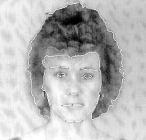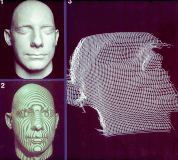Our faces are used extensively in commmunication and recognition. There are many potential applications for systems which can deal efficiently with faces, but the subtle differences between individuals' appearances makes this a challenging task.
 Video coding has applications in videophones and the production of
synthetic image sequences for public announcements. Transmitting
sequences of high quality moving images through digital
telecommunication systems is expensive. One way of reducing the amount
of information needed, whilst maintaining picture quality, is to use
model-based methods. One way of reducing the amount of information
needed, whilst maintaining picture quality, is to use model-based
methods. One approach being developed is to register a 3-dimensional
(3D) wire frame model of the head and shoulders on to an image frame
(Figs 1 and 2). Features that are key to the animation of the image are
selected. The motion of these features in the following image sequence
can be described, the model animated appropriately, and the image
sequence re-synthesised (Fig 3). Good correlation with the actucal image
(Fig 4) is obtained, with the information transmitted being dramatically
reduced.
Video coding has applications in videophones and the production of
synthetic image sequences for public announcements. Transmitting
sequences of high quality moving images through digital
telecommunication systems is expensive. One way of reducing the amount
of information needed, whilst maintaining picture quality, is to use
model-based methods. One way of reducing the amount of information
needed, whilst maintaining picture quality, is to use model-based
methods. One approach being developed is to register a 3-dimensional
(3D) wire frame model of the head and shoulders on to an image frame
(Figs 1 and 2). Features that are key to the animation of the image are
selected. The motion of these features in the following image sequence
can be described, the model animated appropriately, and the image
sequence re-synthesised (Fig 3). Good correlation with the actucal image
(Fig 4) is obtained, with the information transmitted being dramatically
reduced. Face recognition has many potential uses, such as characterising and
retrieving mug-shots for police purposes, and in security systems. One
aproach to recognition is to create a statistical model of the human
face, by analysing the shapes, position and relationship between
features for a large number of faces. Thus, the average positions of
facial features are determined. Using this model features can be located
by knowing their position relative to an initial, identified feature,
e.g. having located the mouth, the system can search in the right place
for the chin. The precise location of features is achieved using a
variety of techniques. The chin can be located using edge detection,
whereas the eyes are characterized by an area of varied grey levels
amidst the relatively homogeneous facial region.
Face recognition has many potential uses, such as characterising and
retrieving mug-shots for police purposes, and in security systems. One
aproach to recognition is to create a statistical model of the human
face, by analysing the shapes, position and relationship between
features for a large number of faces. Thus, the average positions of
facial features are determined. Using this model features can be located
by knowing their position relative to an initial, identified feature,
e.g. having located the mouth, the system can search in the right place
for the chin. The precise location of features is achieved using a
variety of techniques. The chin can be located using edge detection,
whereas the eyes are characterized by an area of varied grey levels
amidst the relatively homogeneous facial region. Techniques to stimulate surgical procedures not only help surgeons plan
operations, but can also increase the quality of patient care. One such
approach aids facial surgery by creating a 3D model of the patient's
head using Moire fringe techniques. Light is projected through a grating
on to a patient's face (Fig 1). The band of shadows that form are
distorted by the facial features. These bands are then viewed by a
camera through a second grating. The interaction between the second
grating and the bands, produces the Moire fringe-a contour map of the
face (Fig2). This depth information can then be used to create 3D models
(Fig3). Accuracy is high, because the data is captured in seconds,
avoiding errors due to movement. Software is being developed to
represent the effects of surgery on the model.
Techniques to stimulate surgical procedures not only help surgeons plan
operations, but can also increase the quality of patient care. One such
approach aids facial surgery by creating a 3D model of the patient's
head using Moire fringe techniques. Light is projected through a grating
on to a patient's face (Fig 1). The band of shadows that form are
distorted by the facial features. These bands are then viewed by a
camera through a second grating. The interaction between the second
grating and the bands, produces the Moire fringe-a contour map of the
face (Fig2). This depth information can then be used to create 3D models
(Fig3). Accuracy is high, because the data is captured in seconds,
avoiding errors due to movement. Software is being developed to
represent the effects of surgery on the model.